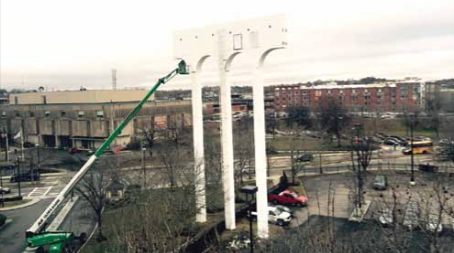May 6, 2016

Workers inspected a sign tower on Mt. Vernon St in March. Control of the sign’s future use is one of several issues that have become contentious between UMass Boston and Corcoran Jennison. Bill Forry photo
Updated May 6, 12 p.m. -- With construction projects crisscrossing its campus, UMass Boston officials last Wednesday hosted the university’s annual community forum to update the public on several campus projects. But an ongoing property dispute centered at the former Bayside Exposition Center property – now controlled by UMass – emerged as a flash point midway through the meeting.
UMass Boston purchased the Bayside parcel in May 2010. A major element of its plans for renovating the 100-plus acre compound is the demolition of the former Bayside Expo building to make way for 600 new parking spaces and a reconfigured shuttle bus area.
Corcoran Jennison Companies, a longtime stakeholder on the Columbia Point peninsula, owns the Bayside Office Center (the Reporter has its offices in the building) and the adjacent Doubletree Hotel on Mt. Vernon Street, along with other nearby holdings, including the 1,284-unit Harbor Point on the Bay apartment complex.
A long-simmering dispute over land use, easements, and property ownership on the Bayside section of Columbia Point between the university and Corcoran Jennison has become increasingly public in recent months. The unadorned three-legged white sign towering over Mt. Vernon Street just down from Kosciuszko Circle that once promoted events at the now-closed Bayside site is a particularly visible emblem of the conflict.
Michael Corcoran, the president of Corcoran Jennison Companies, asserts that the university is purposely holding off on removing the sign as leverage in negotiations about land use on the Bayside site.
“Each of us have different rights on some of the other properties that potentially could impinge on future development,” said Ed Lambert, the university’s chancellor for government relations and public affairs. "And so we have tried to work with the parties there at the Bayside to see if we could fairly and equitably remove those impingements across the board, not just for one development, but all future developments there. We’ll continue to try to do that.”
Lambert added that they also needed to be mindful of independent plans on the part of the Boston Teachers Union, which has a building on Bayside site.
In response, Corcoran had harsh words for the university: “My last conversation with the university building authority, after years and years of trying to get our job going, trying to figure out the sign – and the sign is useless, to anybody, nobody has a desire for that sign – we went in, and we’ve seen everybody,” he said. He added that his company has declined an offer from the UMass Building Authority to buy the remaining Corcoran Jennison property.
The squabble has led to long delays to BRA-approved building projects,including Corcoran Jennison’s plans to build a 184-unit apartment building and commercial space on its Mt. Vernon Street property.
Mayor Martin Walsh told the Reporter Friday morning that he has met with both Corcoran Jennison and UMass Boston on the matter, but the city does not have much jurisdiction beyond approving building on the Corcoran Jennison site.
“It seems like a bigger issue there, and the answers need to be answered through the, I think it’s the UMass Building Authority and the Corcoran family,” Walsh said. “They need to work this thing out.”
One of the delayed initiatives, the Utility Corridor and Roadway Relocation (UCRR) project, has been stalled in areas of the campus that have been built on landfill. The utility and roadway alterations and installations will require excavating about 195,000 tons of landfill, according to UMass Boston. “It is an incredibly vital project for this university, and not an inexpensive one,” Lambert said.
A sample of soil on the site of the onetime landfill that was tested in December found traces of asbestos, said UMass Boston spokesperson DeWayne Lehman in an email. Since then, “subsequent tests of additional soil samples have not found the presence of asbestos, and all the air monitoring/testing has been negative for the presence of asbestos,” Lehman wrote.
Asbestos is only harmful when airborne, Lehman noted, adding that the university is working to minimize any airborne particulates in the areas currently being evaluated with the Department of Environmental Protection. The utility project remains under way behind the Calf Pasture pumping station, he said.
In other actions: In February, the university announced that it expected to open a 1,000- bed dormitory complex in 2018. Some at the meeting pushed back against the height of the dorms, saying while they may be cohesive with the university’s buildings on the Point, they were out of place with the broader Columbia Point aesthetics.
Lambert said the two-building design, with a lower portion in the middle, “is to ensure that it wasn’t this large monolith that would just stand there and block views.” He said they would work with civic associations to design the sight lines.
UMass also presented a snapshot of its current student demographics. Students of color make up 48 percent of the its enrollment numbers, and just under a third live in Boston. Of the 5,525 students residing in Boston, 16 percent (2,695) live in Dorchester, dwar ng the 3 percent living in Roxbury and Mission Hill, the 2 percent living in Allston/Brighton, and the 1.5 percent living in South Boston.
The current dormitory plan calls for 2,000 beds, housing a fraction of the university’s 17,000 students, Lambert said. “We’ll never be a UMass Amherst, which has 70 percent of its students living on campus,” he added.
University officials have said the primary reason for housing students, specifically freshmen and transfers, in marked increases in student success when they live on campus in their first year.


